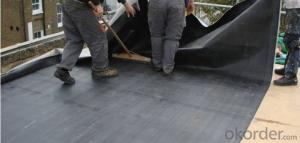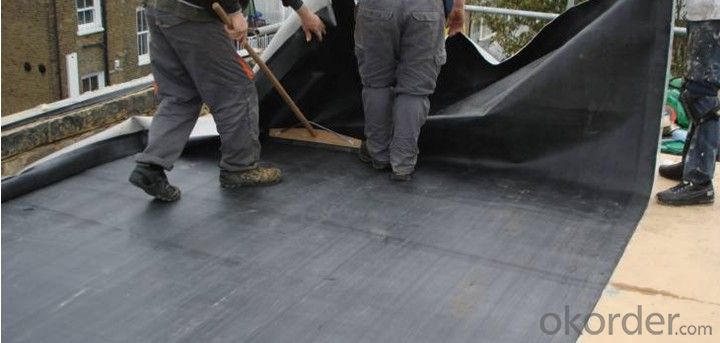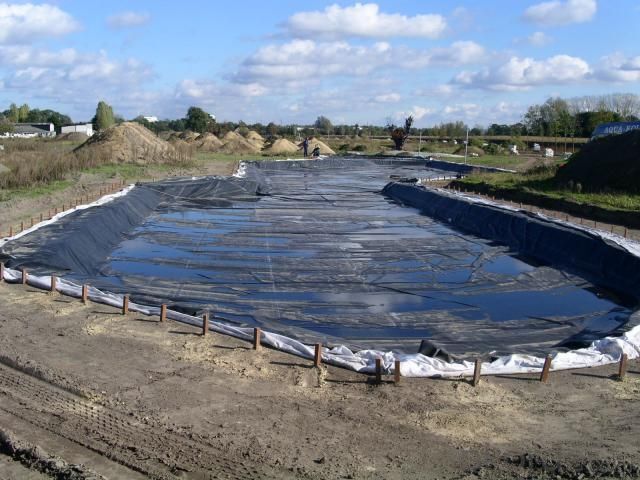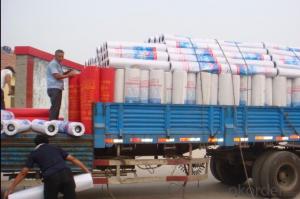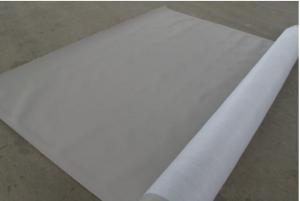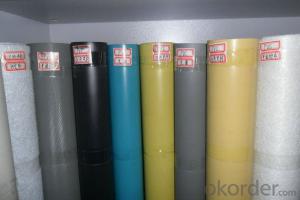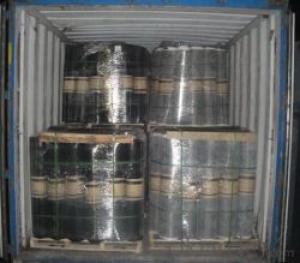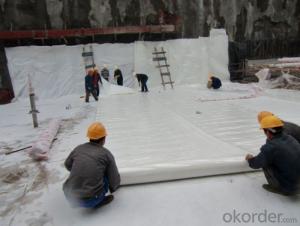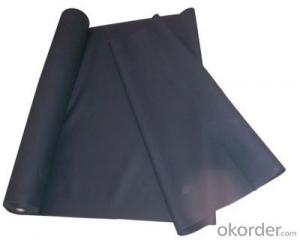EPDM Rubber Waterproof Membrane for Green Roof
- Loading Port:
- Shanghai
- Payment Terms:
- TT OR LC
- Min Order Qty:
- 50000 m²
- Supply Capability:
- 5000000 m²/month
OKorder Service Pledge
OKorder Financial Service
You Might Also Like
EPDM Rubber Waterproof Membrane for Green Roof
Description Of EPDM Rubber Waterproof Membrane for Green Roof:
This waterproof coiled material is of high elasticity with best performance among high polumer waterproof coiled material in the world.It is also the most typical one in the world.Waterproof coiled material made of ternary ethylene-propylene rubber is produced with the use of the most advanced contiuous extrusion and vulcanization technology and related equipments which are specially designed for production of such product.It is good in compactness,without bubble and performance difference in length and breadth,perfomances reach or exceed the demands of GB18173.1-2000 standard.
Main Features of EPDM Rubber Waterproof Membrane for Green Roof:
1.EPDM waterproof membrane for bridge engineering waterproof
2.EPDM waterproof membrane for water conservancy projects ,such as river bank,lake dam seepage.
3.EPDM waterproof membrane for the municipal engineering.
4.EPDM waterproof membrane for aquaculture.
Specifications of EPDM Rubber Waterproof Membrane for Green Roof:
| Number | Item | Unit | Value | |
| 1 | Size Variation | Thichness | % | ±10 |
| Width | % | ±1 | ||
| Length | % | Allowed negative | ||
| 2 | Breaking tensile strength at normal temperature | Mpa | ≥7.5 | |
| Breaking tensile strength at 70°C | Mpa | ≥2.3 | ||
| 3 | Breaking elongation at normal temperature | % | ≥450 | |
| Breaking elongation at -20°C | % | ≥200 | ||
| 4 | Tear strength | KN/m | ≥25 | |
| 5 | Impermeability(30min) | * | 0.3Mpa no leakage | |
| 6 | Bending at low tempreture | °C | ≤-40 | |
| 7 | Stretch tensor at heating | Elongate | mm | ≤2 |
| Shrink | mm | ≤4 | ||
| 8 | Air oven aging(80°C×168h) | Tensile strength at break retained | % | ≥80 |
| Elongation at break retained | % | ≥70 | ||
| 9 | Anti-alkali | Tensile strength at break retained | % | ≥80 |
| Elongation at break retained | % | ≥80 | ||
| 10 | Nuture weathing at manual simulation | Tensile strength at break retained | % | ≥80 |
| Elongation at break retained | % | ≥70 | ||
Applications of EPDM Rubber Waterproof Membrane for Green Roof:
Widely used in roofs, basement, toilet ,swimming pool, and all kinds of industry and civil building waterproofing, reservoir, vivicism, bridge, underground, tunnel and dam waterproofing ,especially to the keystone waterproofing projects which is durability, high corrosion resistance and easy deformation.
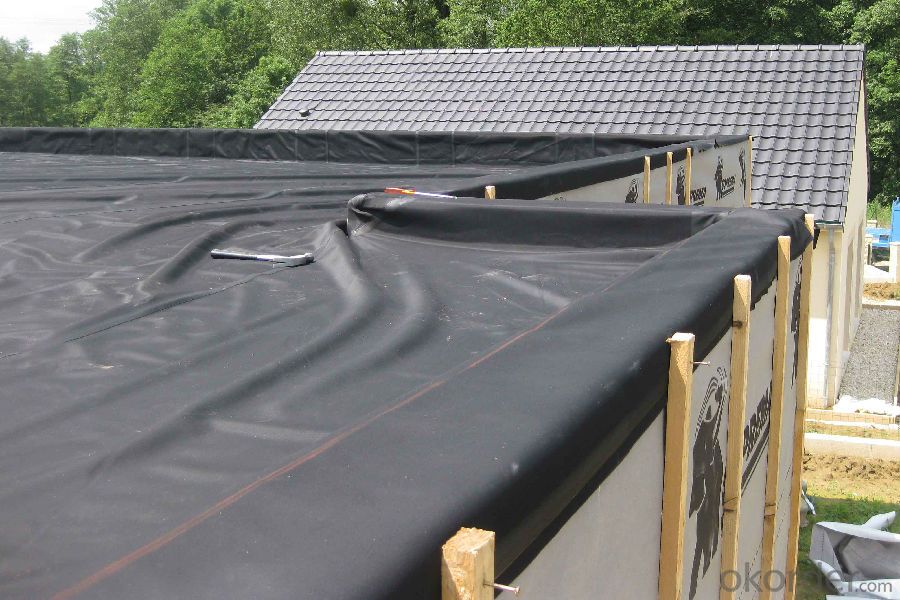


IMages of EPDM Rubber Waterproof Membrane for Green Roof:
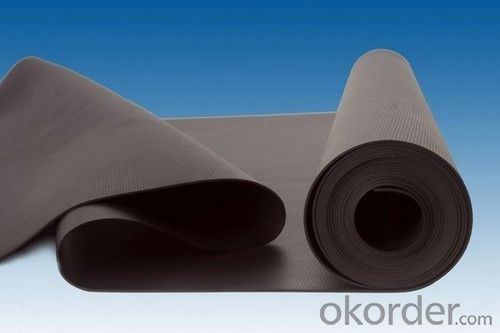



FAQ of EPDM Rubber Waterproof Membrane for Green Roof:
1. What are we supplying?
We are specialized in producing Colorful Asphalt Roof Shingle, SBS/APP modified bitumen waterproof membrane, Self adhesive bitumen waterproof membrane, PVC waterproofing membrane, EPDM rubber roofing membrane, Single Component Polyurethane Waterproof Coating, and Spray Polyurea Waterproof Coating
.
2. How Many years experience do we have?
We have been exported to more than 20 countries in the past 15 years.
3. How long do we usually reply your request?
We always reply our customer within 24 hours.
- Q: How does a waterproofing membrane handle differential settlement?
- A waterproofing membrane is designed to provide a barrier against water infiltration and protect the underlying structure from moisture damage. However, when it comes to handling differential settlement, the performance of the waterproofing membrane can be affected. Differential settlement refers to the uneven settling of the ground or the building foundation, which can lead to variations in the height or level of different parts of the structure. This can create stress and movement in the building, potentially affecting the waterproofing membrane. To address differential settlement, waterproofing membranes are typically designed to be flexible and able to accommodate minor movements without compromising their effectiveness. They are often made from materials such as modified bitumen, polyurethane, or rubberized asphalt, which have inherent elasticity and can stretch or contract to some extent. In cases of minor differential settlement, where the movement is within the tolerances of the membrane, it can adjust and remain intact, maintaining its waterproofing capabilities. However, if the settlement is significant or beyond the membrane's capacity to flex, it may cause the membrane to crack or tear, leading to potential water leakage. To mitigate the impact of differential settlement, additional measures may be taken during the installation of the waterproofing membrane. This could include incorporating stress relieving elements such as expansion joints or using specialized installation techniques that allow for movement. These measures help to distribute the stress caused by settlement and reduce the strain on the waterproofing membrane. It is important to note that while waterproofing membranes are designed to handle some level of differential settlement, they are not a solution for structural issues or significant settlement problems. In cases of severe settlement, it is crucial to address the underlying cause of the settlement and potentially involve a structural engineer to determine the appropriate remediation measures. In conclusion, a waterproofing membrane can handle differential settlement to a certain extent by being flexible and accommodating minor movements. However, it is essential to consider the severity of settlement and implement additional measures during installation to ensure the long-term effectiveness of the waterproofing system.
- Q: Can a waterproofing membrane be used for elevator shafts and stairwells?
- Yes, a waterproofing membrane can be used for elevator shafts and stairwells. Elevator shafts and stairwells are areas that are prone to moisture and water infiltration, especially in below-grade or high-moisture environments. Waterproofing membranes are designed to provide a barrier against water penetration and protect the structure from potential damage caused by moisture. When applied correctly, a waterproofing membrane can effectively prevent water from seeping into elevator shafts and stairwells, keeping them dry and free from water-related issues such as mold growth, deterioration of materials, and structural damage. These membranes are typically made from durable materials such as modified bitumen, PVC, or rubberized asphalt, which offer excellent waterproofing properties. It is important to choose a waterproofing membrane that is specifically designed for below-grade or high-moisture applications. These membranes should have high resistance to hydrostatic pressure, be capable of bridging cracks, and have long-term durability to withstand the constant exposure to moisture. Additionally, the installation of a waterproofing membrane in elevator shafts and stairwells should be done by trained professionals who have experience in waterproofing systems. This will ensure that the membrane is installed correctly, providing an effective barrier against water infiltration. In summary, a waterproofing membrane is a suitable solution for elevator shafts and stairwells as it can effectively prevent water penetration and protect the structure from moisture-related issues.
- Q: What are the requirements for frost resistance of basement floor polymer waterproofing membranes?
- Requirements are, when the material quality testing, the ground temperature must meet the requirements of national norms.
- Q: Can a waterproofing membrane be used in interior or exterior applications?
- Yes, a waterproofing membrane can be used in both interior and exterior applications. In interior applications, such as basements or bathrooms, a waterproofing membrane can be installed on walls or floors to prevent water or moisture from seeping through. This helps to protect the underlying structure from damage caused by water intrusion. In exterior applications, a waterproofing membrane can be applied to the exterior walls or foundations of a building to prevent water from penetrating into the structure. This is especially important in regions with heavy rainfall or high water tables. By creating a barrier against water, the membrane helps to keep the interior of the building dry and free from water damage. Overall, the use of a waterproofing membrane in both interior and exterior applications is essential for ensuring the longevity and durability of a structure by protecting it from water-related issues.
- Q: Can a waterproofing membrane be used on precast cement board surfaces?
- Precast cement board surfaces, commonly utilized in construction, particularly for exterior applications, can benefit from the application of a waterproofing membrane. These surfaces are not inherently waterproof, making it necessary to add an extra layer of protection against water infiltration. The waterproofing membrane, a thin material layer, serves as a barrier on the cement board surface. Its primary function is to prevent water from penetrating the board and reaching the underlying structure. This becomes particularly crucial in areas exposed to moisture, such as bathrooms, kitchens, and outdoor installations. Various types of waterproofing membranes are available, including liquid-applied membranes and sheet membranes. Liquid-applied membranes can be rolled or sprayed onto the surface, while sheet membranes are applied similarly to stickers. Both options effectively waterproof precast cement board surfaces. When selecting a waterproofing membrane for precast cement board surfaces, it is vital to consider the specific requirements and conditions of the project. Factors such as water exposure level, climate, and intended use of the surface should be taken into account. Following the manufacturer's instructions for application is also crucial, as proper installation significantly impacts the membrane's effectiveness. To summarize, the utilization of a waterproofing membrane on precast cement board surfaces provides an additional safeguard against water infiltration. This wise choice is especially beneficial in moisture-prone areas, ultimately extending the lifespan of the cement board and preventing harm to the underlying structure.
- Q: Are waterproofing membranes resistant to hydraulic oils?
- No, waterproofing membranes are not typically resistant to hydraulic oils.
- Q: Can a waterproofing membrane be used for swimming pool coping?
- No, a waterproofing membrane cannot be used for swimming pool coping. Coping refers to the material used to cover the top edges of the pool walls and is typically made of concrete, stone, or tile. It is primarily used to provide a finished look and protect the pool structure from water damage. On the other hand, a waterproofing membrane is a material applied to the surface of a structure, such as a basement or roof, to prevent water infiltration. While both serve the purpose of water protection, they are designed for different applications and are not interchangeable.
- Q: Does a waterproofing membrane have any fire-resistant properties?
- No, a waterproofing membrane does not typically have any fire-resistant properties.
- Q: Can a waterproofing membrane be used for a plaza deck waterproofing?
- Plaza deck waterproofing necessitates the use of a waterproofing membrane as they are consistently exposed to the elements, such as rain and snow. This is crucial in preventing water infiltration and potential harm to the underlying structure. Waterproofing membranes are specially designed to serve this purpose and safeguard the deck against moisture-related problems like leaks, deterioration, and mold formation. These membranes are typically constructed from materials like bitumen, PVC, or EPDM, and are applied in multiple layers to guarantee a strong and impermeable seal. By utilizing a waterproofing membrane, plaza decks can effectively preserve their structural integrity and longevity.
- Q: Can a waterproofing membrane be exposed to sunlight?
- Yes, a waterproofing membrane can be exposed to sunlight. In fact, many waterproofing membranes are designed to withstand prolonged exposure to sunlight without deteriorating or losing their effectiveness. However, it is important to note that not all waterproofing membranes are equally resistant to UV rays, so it is crucial to choose a membrane that is specifically designed for outdoor use and can handle exposure to sunlight. Additionally, it is always recommended to follow the manufacturer's instructions and guidelines for the specific waterproofing membrane being used to ensure its longevity and performance.
Send your message to us
EPDM Rubber Waterproof Membrane for Green Roof
- Loading Port:
- Shanghai
- Payment Terms:
- TT OR LC
- Min Order Qty:
- 50000 m²
- Supply Capability:
- 5000000 m²/month
OKorder Service Pledge
OKorder Financial Service
Similar products
Hot products
Hot Searches
Related keywords
